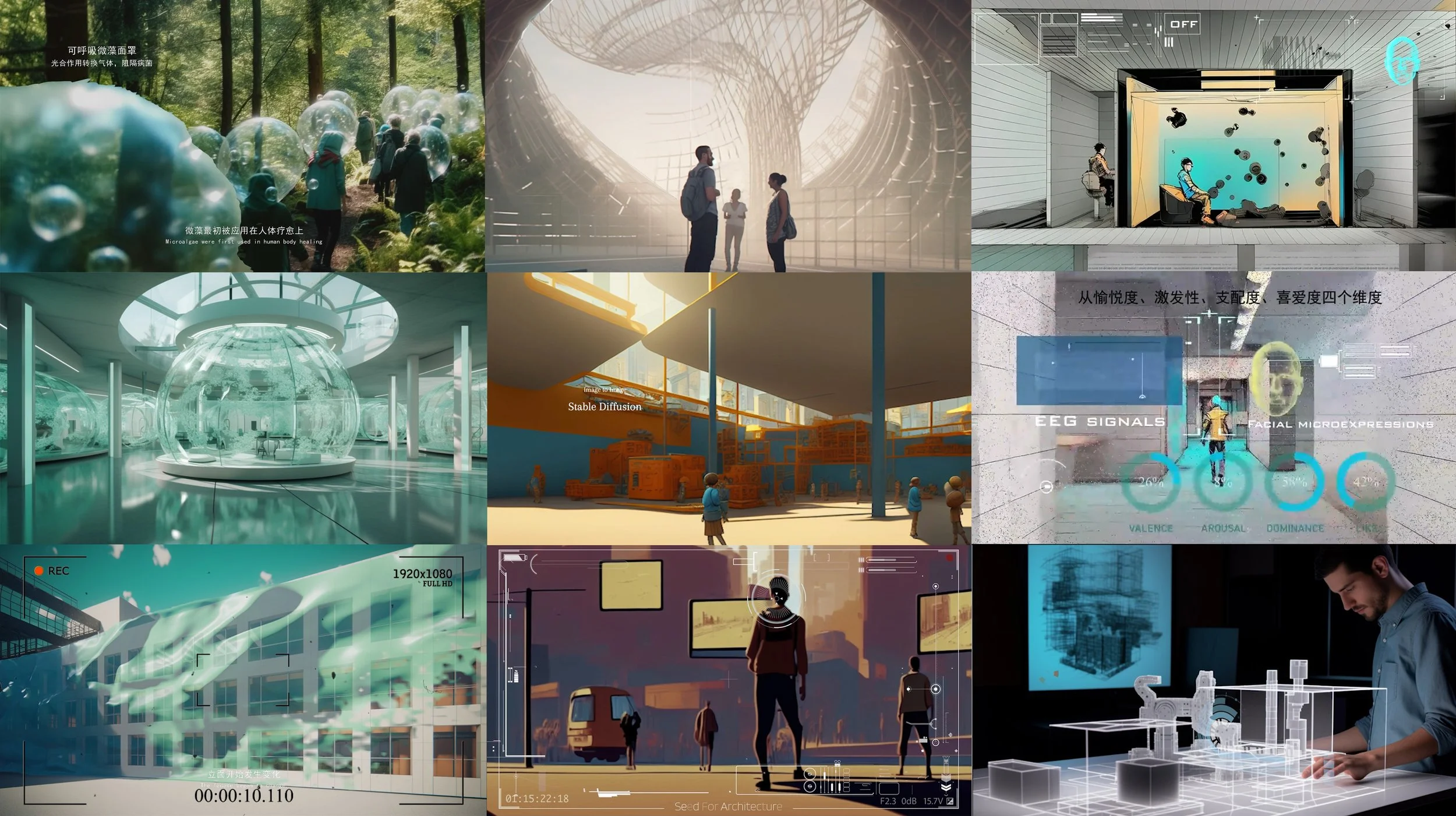Imagination of Future Architecture School in 2035 / Generative AI Short Film
建院未来畅想2035 / AI生成式影像
Design Studio Pedagogy Exploration in the Age of Generative AI 生成式AI时代的设计教学探索
Tsinghua University School of Architecture Third Year Advanced Studio
Design Critics: Jiajian Min , Anna Borou Yu Collaborative Design Critic: Xin Zhang Teaching Asistant: Shuyu Luo Special Lecturer: Huazhe Xu, Zeyu Wang, Tiange Zhou, Feiran Jiang, Jingfang Hao Year: 2023
清华大学建筑学院2023年三年级开放式设计教学课程
设计导师:闵嘉剑,于博柔 联合设计导师:张昕 助教:罗书宇 特邀讲座:许华哲、王泽宇、周天歌、蒋斐然、郝景芳
The ascent of Generative AI will engender a notable transformation in architectural design and education. Considering the distinctive attributes of Generative AI of original content generation, natural language interaction, and multi-modal cross-media functionality, design education could be empowered by teaching the ability to master and create AI tools, with the aim of enhancing students' imaginative and creative capacities. In the context of this paradigm shift, the studio entitled "Imagination of Future Architecture School in 2035 / Generative AI Short Film" encourages the students to explore prospective technological, pedagogical, and spatial dimensions envisioned for architectural education in the year 2035. This endeavor involves the utilization of AI tools for the creation of short films throughout the entire process. By adopting a problem-based learning approach and redefining the roles of educators, this studio seeks to foster interdisciplinary thinking among students and facilitate cross-media expression. It explores a new way to nurture innovative talents in the field of architecture.
KEY WORDS: Generative AI; architectural education; world building; short film; interdisciplinary studies; cross-media; innovative talent cultivation
随着生成式AI的兴起,建筑设计与建筑学教育将被重新赋能。基于生成式AI的原创内容生成、自然语言交互、多模态跨媒介等特点,设计教学可以通过传授驾驭和创造AI工具的能力,提高学生的想象力与创作力。《建院未来畅想2035/AI生成式影像》课程引导学生畅想2035年人工智能对建筑学教育的影响,以建筑学院为事件空间进行世界构建,利用AI工具全流程创作影像短片。通过基于问题的学习与教师角色的转变,旨在培养学生跨学科思维方式、跨媒介表达方法,探索建筑学创新型人才培养的新路。
关键词:生成式人工智能;建筑教育;世界构建;影像;交叉学科;跨媒介;创新型人才培养
Paul_s Cat AI Film
Students: Yan Xiaoyu, Zhang Xin 学生:撖晓雨 张馨
In 2035, the School of Architecture implemented the "seed+cell+farm" model through AI deep learning, enabling a new nomadic place combination method that supports personalized learning for students. The film tells the story of the recurring encounters between Paul and an AI cat, showcasing a delightful vision of the coexistence of future architectural technology and humanistic care in the building.
2035年建筑学院通过AI深度学习实施"seed+cell+farm"模式,以新游牧式场所组合方式,支持学生个性化学习。影片通过Paul和AI猫的循环相遇故事,展现未来建筑馆技术与人文关怀共存的美好图景。
Affective Space 情绪空间 2035
Students: Ai Mingsi, Long Yuhang 学生:艾明思 龙宇航
In the year 2035, affective computing technology will be integrated into teaching and design. Utilizing vast emotional data, the architecture building will be transformed into an intelligent structure. The film explores the possibilities of combining affective computing technology with architecture. Through the hypothetical concept of affective space, it delves into the relationship between architectural spaces and the psychological states of their occupants.
2035年,将情感计算技术融入教学与设计中,并利用情感的大数据信息将建筑馆建成一座智能建筑。影片探讨情感计算技术与建筑结合的可能性,并借由情绪空间的假想,思考建筑空间与使用者心理的关系。
P-Arch
Student: Wang Yuhan 学生:王雨涵
In 2035, screens have become the carrier for various XR technologies, ensuring real-time interaction between humans and AI, and serving as a crucial component of building spaces. The film portrays screens as the medium for architectural narratives, spatial language, and spatial practices. It envisions the AI assistant P-Arch influencing the learning patterns in architecture through various screen interfaces.
屏幕在2035年成为各种XR技术的载体,人与AI实时交互的保障,以及建馆空间的重要组成部分。影片将屏幕作为建筑叙事、空间语言和空间实践的载体,构想AI助手P-Arch通过各类屏幕界面对建筑学学习模式的影响。
Cyber Microalgae 赛博微藻
Students: Liu Xinyang, Zheng Haozhun
In 2035, a new type of microorganism called Cyber Microalgae, synthesized from microalgae and nanobots, exhibits highly intelligent characteristics. They play a role in constructing self-circulating systems for zero-carbon buildings. The architectural spaces they form actively contribute to healing-oriented architectural living through features such as soft interfaces, gas conversion, adaptive forms, and more.
学生:刘馨阳、郑皓准
2035年,由微藻和纳米机器人合成的新型微观生物——赛博微藻具有高度智能化的特性,它们参与构建零碳建筑的自循环系统,形成的建筑空间从柔软界面、气体转换、自适应形体等方面积极参与到治愈性的建筑生活中。




